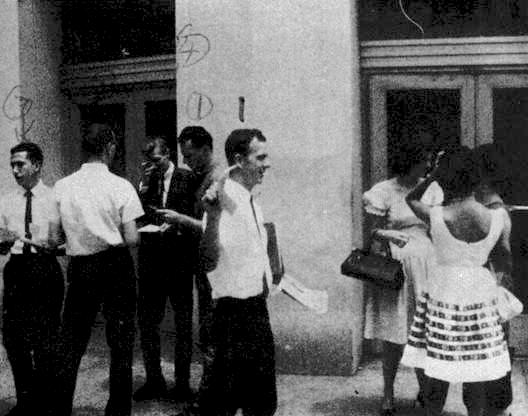
Who was Lee Harvey Oswald?
At 12:20 p.m., in the basement of the Dallas police station, Lee Harvey Oswald, the alleged assassin of President John F. Kennedy, was shot to death by Jack Ruby, a Dallas nightclub owner. The whole incident was captured on live television, shocking viewers who witnessed the crime. Here are a few of the most popular questions we are asked during our JFK Tour related to Lee Harvey Oswald.
Q: Did Oswald kill Kennedy? Did he act alone?
A: The Warren Commission, established by President Lyndon Johnson to investigate the assassination, concluded, in 1964, that Oswald acted alone, firing three shots from a window in his Dallas workplace, the Texas School Book Depository. Many Americans have questioned this conclusion. In 1978, the House Select Committee on Assassinations ended its own inquiry by finding that Kennedy “was probably assassinated as a result of a conspiracy.
Q: What was Oswald’s childhood like?
A: Unstable. By the time he turned 17 and joined the Marines, he’d lived at more than 20 different addresses and attended a dozen schools. He was born in New Orleans on Oct 18, 1939, two months after his father died of a heart attack, spent time in an orphanage, as a three-year-old, and moved with his family to Dallas in 1944. He and his mother moved, in 1952, to New York City, where he had run-ins with truant officers and underwent psychiatric observation. Two years later, they moved back to New Orleans.
Q: How did he fare in the Marines?
A: Erratically. In early phases of his service, at US bases, he got good performance evaluations and qualified as a sharpshooter, after marksmanship training. But he was court-martialed twice while stationed in Japan, first after wounding himself with an unauthorized pistol and, later, after a bar fight. He tried to teach himself Russian, and — at the height of the Cold War — would speak favorably of Marxism and the Soviet Union.
Q: Did he try to defect to Russia?
A: Yes. He obtained an early discharge from the Marines, and, in 1959, he traveled to Finland and boarded a train to Moscow. Soon after arrival, he told his guide he wanted to defect. Russian authorities initially rebuffed him (he slit his wrist in response), but eventually allowed him to stay and sent him to the city of Minsk, to work at an electronics factory. In March, 1961, Oswald met Marina Prusakova, a 19-year-old pharmacology student. They married within six weeks and had a child in February, 1962. That May, weary with life in Russia, Oswald and his wife applied at the American Embassy, in Moscow, for documents enabling her to emigrate to the US. They settled in Dallas that autumn.
Q: Wasn’t Oswald linked to another assassination plot?
A: On Apr 10, 1963, a gunman shot through a window of the Dallas home of Major General Edwin Walker, a fervent anti-communist and segregationist, who resigned from the Army after being reprimanded for giving troops right-wing propaganda. Walker, working at a desk, was slightly injured by fragments. The Warren Commission later concluded Oswald was the gunman.
Q: What’s the Cuban connection in Oswald’s life?

A: In late April, 1963, just days after the attack on Walker, Oswald went to New Orleans and spent the summer there. He printed and distributed leaflets in support of Cuba’s Communist leader, Fidel Castro, and got into a street fight with anti-Castro demonstrators. Yet the leaflets bore an address of a local anti-Castro operation, connected to a former FBI agent. That September, Oswald took a bus to Mexico City and visited the Cuban and Soviet embassies, in an unsuccessful effort to get clearance to travel to Russia via Cuba.
Q: How was Oswald arrested on Nov 22?

A: The Warren Commission said Oswald left the book depository moments after shots were fired from the sixth floor, returned by bus and cab to his rooming house, then ventured out again — soon encountering a Dallas police officer, who stopped him based on descriptions of the assassination suspect. According to the commission, Oswald fatally shot patrolman, JD Tippit, with a handgun, then fled into a nearby movie theater, where he was soon arrested.
Q: Who was Jack Ruby?

A: Ruby was a Dallas nightclub owner, well-acquainted with many police officers. As Oswald was being transferred from police headquarters to the county jail, on Nov 24, Ruby shot him in the chest, from close range. Oswald was rushed, unconscious, to Parkland Memorial Hospital — where doctors had tried to save Kennedy’s life two days earlier — and died there at 1:07pm. Ruby was convicted of murder and sentenced to death. He appealed and was granted a new trial, but died of lung cancer before a trial date was set. Ruby said he was angered by Kennedy’s assassination and wanted to spare Jacqueline Kennedy the ordeal of a trial for Oswald. Skeptics, noting that Ruby had some connections with underworld figures, have suggested his shooting of Oswald was part of a broader conspiracy.
Q: Did the Warren Commission specify a motive for Oswald killing Kennedy?
A: No. Oswald “was moved by an overriding hostility to his environment,” the report said. “He does not appear to have been able to establish meaningful relationships with other people. He was perpetually discontented with the world around him. Long before the assassination, he expressed his hatred for American society and acted in protest against it.”

